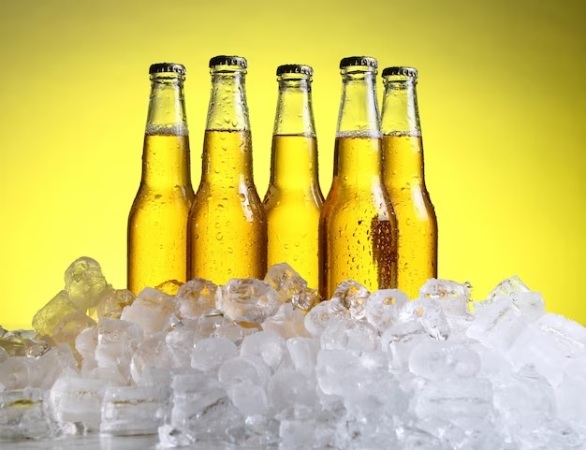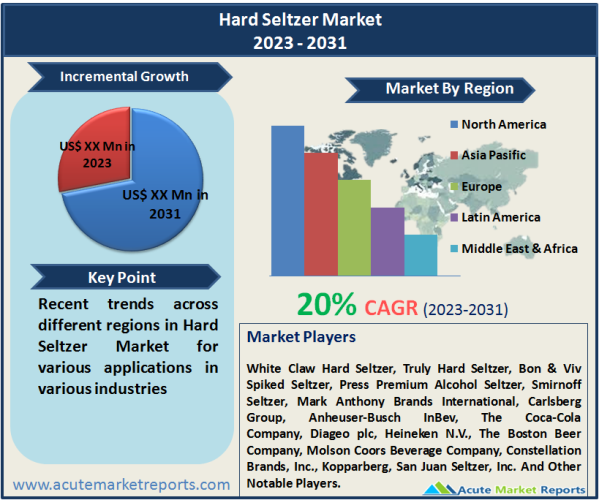
The hard seltzer market is expected to grow at a CAGR of 20% during the forecast period of 2025 to 2033, driven by factors such as the consumer preference for low ABV content, diverse flavor offerings, innovation, and the shift towards sustainable packaging, particularly metal cans. However, challenges related to regulatory changes and taxation policies may present obstacles to market expansion. To thrive in this dynamic market, industry players should focus on product innovation, sustainability, and effective compliance strategies to navigate regulatory challenges successfully. Overall, the hard seltzer market's ability to adapt to changing consumer preferences and regulatory landscapes will be pivotal in determining its future success.

Growing Consumer Preference for Low Alcohol by Volume (ABV) Content
In recent years, there has been a notable shift in consumer preferences towards beverages with lower ABV content, such as hard seltzers with an ABV ranging from 1.0% to 4.9%. This trend can be attributed to health-conscious consumers who seek lighter and more refreshing alcoholic options. Hard seltzers in this ABV range are seen as a healthier alternative to traditional alcoholic beverages, as they often contain fewer calories and sugar. In 2024, the segment of hard seltzers with 1.0% to 4.9% ABV content accounted for the highest revenue within the market. Furthermore, this segment is expected to maintain its dominance and exhibit the highest CAGR during the forecast period from 2025 to 2033.
Diverse Flavor Offerings and Innovation
The hard seltzer market has witnessed a surge in the availability of a wide variety of flavors, including fruit-infused options and creative combinations. These diverse flavor offerings have significantly contributed to market growth, as they appeal to a broader consumer base. Companies in the industry are continually innovating to introduce new and exciting flavors that cater to evolving consumer preferences. Such innovations not only attract new consumers but also encourage repeat purchases. As a result, the diverse flavor options and ongoing innovation are expected to be key drivers of the hard seltzer market's growth in the coming years.
Shift Towards Sustainable Packaging
Another driver of the hard seltzer market is the increasing focus on sustainable packaging, particularly the preference for metal cans. Metal cans are not only recyclable but also offer advantages such as portability and protection from light and oxygen, ensuring the quality and freshness of the beverage. In 2024, metal cans emerged as the dominant packaging type within the market, both in terms of revenue and CAGR. The eco-conscious consumer mindset, coupled with the convenience and sustainability associated with metal cans, is anticipated to boost their adoption further, driving the market's growth.
Regulatory Challenges and Taxation
While the hard seltzer market is experiencing rapid growth, it is not without challenges. One significant restraint is the evolving regulatory landscape and taxation policies related to alcoholic beverages. Governments in various regions have been implementing stricter regulations and imposing higher taxes on alcoholic products, which can directly impact the pricing and distribution of hard seltzers. These regulatory changes can also lead to compliance challenges for manufacturers and may limit the market's expansion to some extent. Navigating these regulatory hurdles and ensuring compliance will be a critical concern for companies operating in the hard seltzer market.
Market Segmentation by ABV Content (1.0% to 4.9%, 5.0% to 6.9%, Others): ABV Content Ranging from 1.0% to 4.9% Dominates the Market
In 2024, the segment of hard seltzers with an ABV content ranging from 1.0% to 4.9% accounted for the highest revenue within the market. This segment is expected to maintain its dominance during the forecast period from 2025 to 2033, with the highest anticipated Compound Annual Growth Rate (CAGR). Consumers are increasingly opting for beverages with lower alcohol content, driven by health-conscious choices. The segment's growth can be attributed to its perception as a healthier alternative to traditional alcoholic beverages, given its lower calorie and sugar content.
Market Segmentation by Packaging Type (Glass Bottles, Metal Cans): Metal Cans Dominate the Market
In 2024, metal cans emerged as the dominant packaging type within the hard seltzer market, both in terms of revenue and CAGR. The preference for metal cans is primarily due to their recyclability, portability, and ability to protect the beverage from factors like light and oxygen, ensuring freshness. Consumers are increasingly eco-conscious, and this preference for sustainable packaging is expected to continue driving the adoption of metal cans, further boosting the market's growth.
North America Remains as the Global Leader
In 2024, North America dominated the market, particularly the United States. North America held the highest revenue percentage due to the early adoption of hard seltzers, strong consumer demand, and the presence of well-established manufacturers. The region's market dominance was also fueled by changing consumer preferences for low-calorie, low-sugar alcoholic beverages and the popularity of different flavors. However, during the forecast period from 2025 to 2033, the Asia-Pacific region is expected to exhibit the highest Compound Annual Growth Rate (CAGR) among all regions. This growth is attributed to the increasing urbanization, rising disposable incomes, and a growing consumer base seeking alternative alcoholic beverages. As economies in the Asia-Pacific region continue to expand, more consumers have the financial means to invest in premium hard seltzer products, contributing to market growth. Additionally, cultural shifts emphasizing healthier drinking options and the appeal of varied flavors are expected to drive the market in this region.
Market Competition to Intensify during the Forecast Period
In the hard seltzer market, several key players compete to gain a competitive edge. While a comprehensive list of players can be extensive, some of the prominent companies in the market include White Claw Hard Seltzer, Truly Hard Seltzer, Bon & Viv Spiked Seltzer, Press Premium Alcohol Seltzer, Smirnoff Seltzer, Mark Anthony Brands International, Carlsberg Group, Anheuser-Busch InBev, The Coca-Cola Company, Diageo plc, Heineken N.V., The Boston Beer Company, Molson Coors Beverage Company, Constellation Brands, Inc., Kopparberg and San Juan Seltzer, Inc., among others. Competitive strategies in the hard seltzer market focus on product innovation, flavor diversity, marketing, and sustainability. Companies are continually introducing new and appealing flavors to attract consumers and differentiate their products. Marketing efforts often target health-conscious consumers, emphasizing the low ABV content, calorie count, and natural flavors. Sustainability is another key focus, with many brands opting for recyclable and eco-friendly packaging, such as metal cans. Additionally, partnerships with distribution channels, including liquor stores, supermarkets, and online platforms, play a crucial role in reaching consumers effectively. Overall, competition in the hard seltzer market is intense, and companies are striving to capture market share by staying attuned to consumer preferences, introducing innovative products, and adopting sustainable practices in both packaging and production.
Historical & Forecast Period
This study report represents analysis of each segment from 2023 to 2033 considering 2024 as the base year. Compounded Annual Growth Rate (CAGR) for each of the respective segments estimated for the forecast period of 2025 to 2033.
The current report comprises of quantitative market estimations for each micro market for every geographical region and qualitative market analysis such as micro and macro environment analysis, market trends, competitive intelligence, segment analysis, porters five force model, top winning strategies, top investment markets, emerging trends and technological analysis, case studies, strategic conclusions and recommendations and other key market insights.
Research Methodology
The complete research study was conducted in three phases, namely: secondary research, primary research, and expert panel review. key data point that enables the estimation of Hard Seltzer market are as follows:
Market forecast was performed through proprietary software that analyzes various qualitative and quantitative factors. Growth rate and CAGR were estimated through intensive secondary and primary research. Data triangulation across various data points provides accuracy across various analyzed market segments in the report. Application of both top down and bottom-up approach for validation of market estimation assures logical, methodical and mathematical consistency of the quantitative data.
| ATTRIBUTE | DETAILS |
|---|---|
| Research Period | 2023-2033 |
| Base Year | 2024 |
| Forecast Period | 2025-2033 |
| Historical Year | 2023 |
| Unit | USD Million |
| Segmentation | |
ABV Content
| |
Packaging Type
| |
Flavor
| |
Distribution Channel
| |
|
Region Segment (2023-2033; US$ Million)
|
Key questions answered in this report